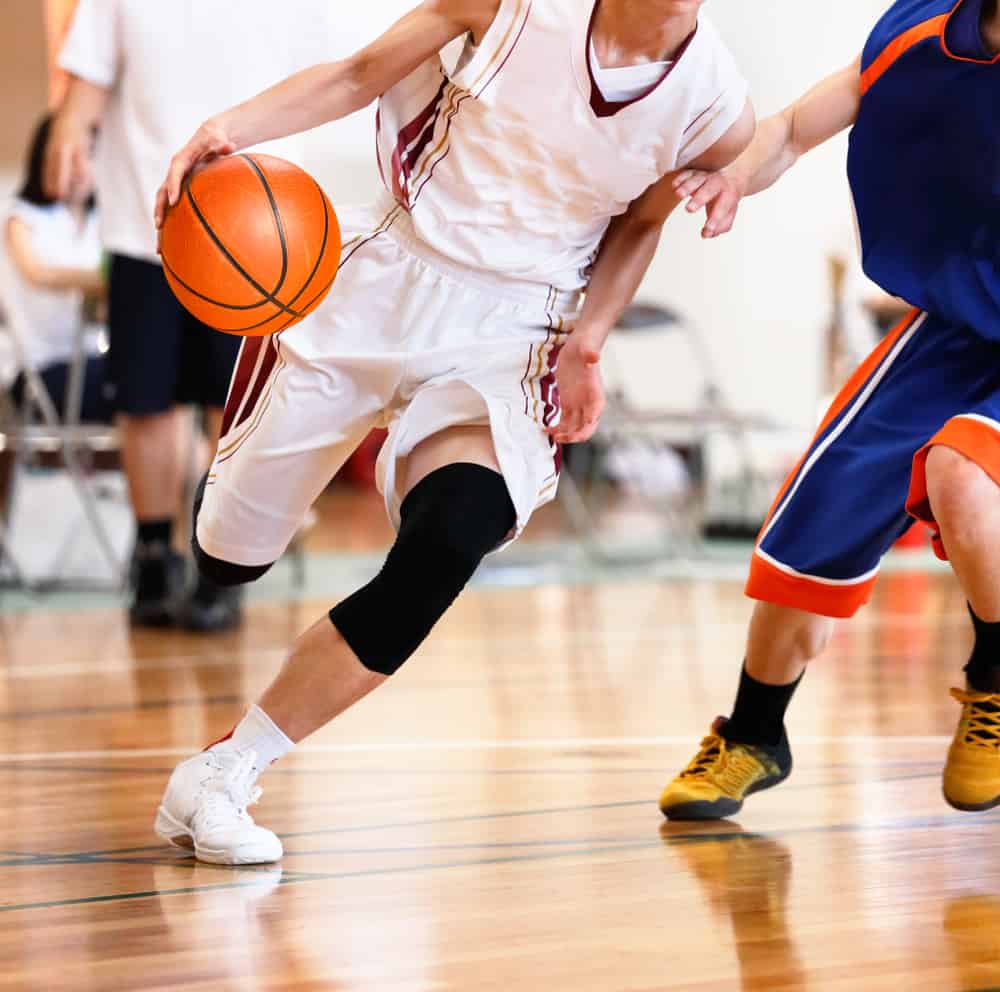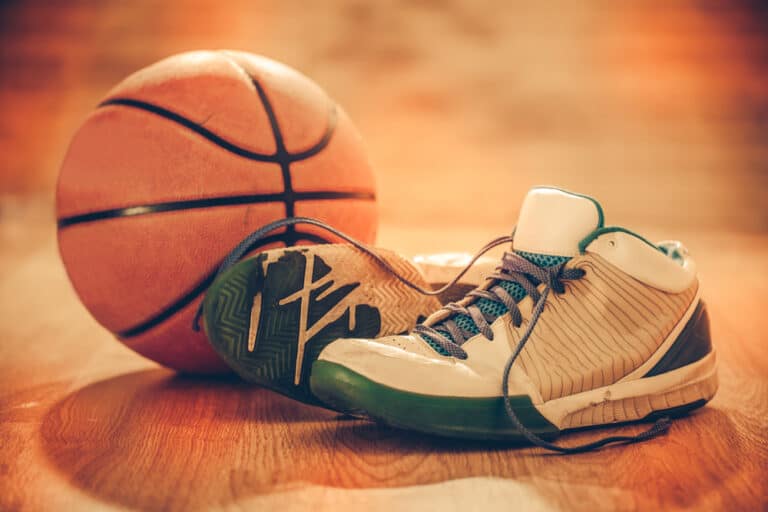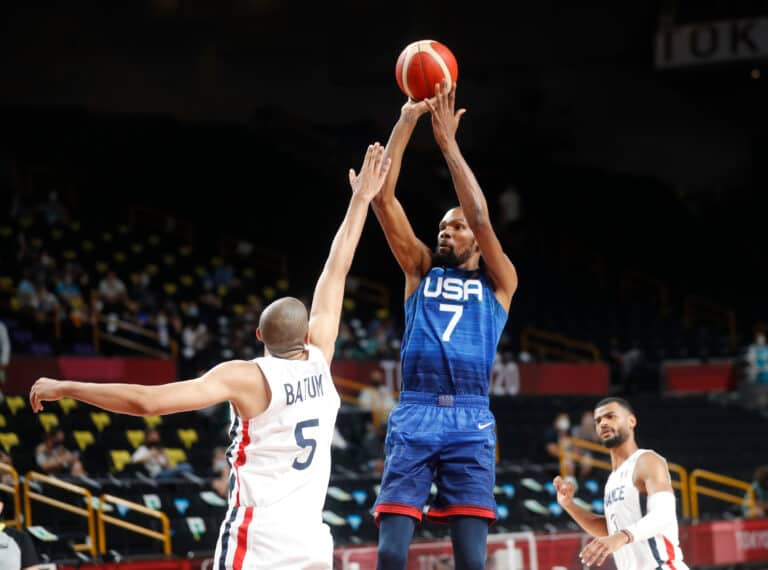Can Both Hands Be Used To Dribble In Basketball? (Here’s The Truth)
Is it legal to use both hands to dribble a basketball? Dribbling rules in basketball can be confusing or unclear at times. The misinterpreting of the law governing the use of the hands while dribbling often leads to heated arguments amongst fans. Let’s clear up the confusion by clarifying the use of the hands and the definition of what constitutes a dribble.
FIBA rules make it clear that only one hand may touch the basketball at any moment. There is no restriction in place that limits the use of both hands while dribbling a basketball. Switching hands between every ball bounce, when changing direction, or whenever the player deems necessary is legal.
In basketball, dribbling is the action of driving a ball along the ground using repeated hand taps. It is a skill that takes hours of practice to perfect, and starting from a young age is advantageous. Unlearning bad dribbling habits takes even longer, so getting it right from the word go is very important. Let’s look at the basics of what dribbling is all about.
Is The Use Of Both Hands To Dribble Legal In Basketball?
Rule 24.1.2 of the official rule book of basketball (FIBA) states that a player may not have two hands touching the basketball simultaneously or place a hand(s) underneath the ball during a dribble. There is no restriction on which hand the player can use to bounce the ball.
The FIBA defines dribbling as a controlled moving of the basketball within the demarcated lines of the basketball court while bouncing, tapping, rolling, or tossing the ball. During the dribble, the player must control the ball at all times.
A dribble starts when the player releases the ball (either with one hand or both hands) and then regains possession of the ball. The basketball must contact the floor before the player touches it again. The ball may also not touch another player (unless unintentionally). The dribble continues with the ball alternating between the player’s hand and the floor (bouncing).
A dribble ends when the player simultaneously places two hands on the ball or rests the ball on the hand palm (even for a brief moment). The player may not start a new dribble, except when losing control during the play, but must pass the ball or attempt to score by shooting the hoop.
What Is The Basketball Rule For Starting A Second Dribble?
FIBA rule 24.2 states that a player may start a second dribble when any one of the following three conditions is met:
- The player regains possession of the ball after a failed attempt at shooting the loop.
- The ball touches another player in an unspecified manner.
- The player fumbles his dribble after an accidental interaction with another player.
Violations Caused By Dribbling Errors In Basketball
Breaking the dribbling rules will raise a double dribble or carry (travel) violation. Starting a second dribble after completion of the initial dribble will lead to a double dribble violation.
Any player attempting to illegally gain an advantage by resting (or carrying) the ball on their palm while moving will be penalized with a palming or carry violation. Players will also receive a carry violation for briefly placing their hand underneath the ball and then flipping it over while making a crossover pass. The rule is clear. Placing a hand or finger(s) on top of the ball is not allowed.
Following the rule infraction, the ball is handed over to the opposing team, who must restart the game at the sideline closest to the area where the violation occurred, except directly behind the backboard. The double dribble violation is often overlooked in the NBA (National Basketball Association) league games.
Handling violations are easy mistakes to make in basketball. It takes hours of practice to gain sufficient muscle memory to avoid the instinct to grab the ball with both hands.
Where Did Basketball’s Double Dribble Rule Originate From?
In 1901 new rules allowed players to bounce the ball once while traveling. The player dribbling the ball was also not allowed to shoot the hoop. In 1909 the rules changed again, allowing the continual bouncing of the ball. The player was also allowed to shoot at the hoop.
Double dribbling was banned to free up the game. Before the rule change, the dribbler could move almost unchecked. The players used to be able to stop and hold onto the ball while evading the defense and then continue dribbling. This freedom allowed certain players to dominate the game to the detriment of other players and the game.
The introduction of the double dribble rule forced teams to pass the ball more frequently, opening up the game and creating more opportunities for the defending team to overturn the ball in their favor. It also enhances the game flow, culminating in a more exciting and beautiful game to be enjoyed by everyone.

How Important Is Dribbling In Basketball?
The dribble is primarily used to get around a defender or to re-position for attempting to score, making the dribble an essential tool in any basketball player’s arsenal. The player that has mastered the various dribbling techniques is more likely to maneuver the ball into a favorable position to attempt a shoot.
The best dribblers can move around the court while dribbling without having to look at the ball. From a spectator’s perspective, it almost appears like the ball is glued to the player’s hand. This ability allows the dribbler to keep his eyes focused on the players around him and plan his next move well in advance.
The Basic Dribbling Technique In Basketball
Being good at dribbling starts with the fingers and wrist. Use widespread fingertips for control and push down on the ball with a stiff hand using wrist and forearm movements only. Do not involve your torso in the activity. Avoid using the palm, as this slows down the dribbling speed and decreases control over the ball.
Your body position is essential in protecting the ball and moving quickly. Keep your stance low with feet apart, about shoulder wide, knees slightly bent, and a straight back. Look up and focus on the players around you. It won’t be easy, but learn to bounce the ball without looking at it. Over time you will instinctively know where the ball will meet your hand on the return bounce.
Bounce the ball with quick, sharp taps while keeping the action low on the ground.
Conclusion
The ability to dribble is a vital skill to have for any basketball player. Practice dribbling so that you can be proficient using one or two hands. Study and understand the game’s rules so you can confidently step out and play the game.
References
- https://www.fiba.basketball/basic-rules#|tab=element_2_1
- https://en.wikipedia.org/wiki/Rules_of_basketball
- https://youtu.be/OK3jNSfm3rM
- https://www.quora.com/Why-is-dribbling-with-two-hands-not-called-in-NBA-games-I-see-centers-usually-do-it-a-lot-after-they-get-a-rebound-They-get-the-rebound-dribble-once-with-both-hands-Isnt-it-considered-a-double-dribble
- https://www.fiba.basketball/documents
- https://en.wikipedia.org/wiki/Double_dribble
- https://www.wikihow.com/Dribble-a-Basketball







